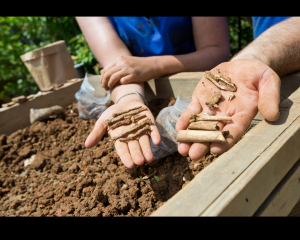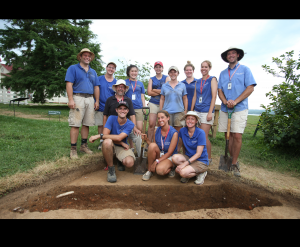- September 14, 2015
- By Karen Shih ’09
After defeating the largest empire on earth and ushering in a new era of democracy as our fledgling nation’s first president, all George Washington wanted was a quiet life as a gentleman farmer at Mount Vernon, overlooking the Potomac River in Virginia.
That’s where, for the third summer, students were on their knees in the blazing sun, sweat trickling down their noses as they carefully scraped away layer after layer of dirt, hoping to reveal the man behind the myth.
“It’s a really great way for us to really understand him as a person and not as this exalted figure who created our country,” says Emma Schrantz, a member of the Mount Vernon/University of Maryland Field School in Historic Preservation who’s applying to the master’s program at UMD. “He was a human being, he had a life and a family, and he made decisions day-to-day about what plates to buy and what food to eat.”
This year, eight students, led by Mount Vernon Deputy Director of Archaeology Eleanor Breen and UMD Historic Preservation Program Director Donald Linebaugh, excavated the south grove next to the kitchen, as well as a slave cemetery.
This is one of the only multidisciplinary preservation field schools that combines archaeological, architectural and museum interpretation, Linebaugh says. “Being able to read both the above-ground and below-ground evidence is really important for preservation practice today.”
The property passed from Washington’s father to his half-brother before coming to Washington in 1754. He gradually expanded the house into a mansion and constructed many outbuildings to support the 8,000-acre estate’s operations over the next 45 years. The estate stayed in the family until 1858, when the Mount Vernon Ladies’ Association bought and preserved it for future generations.
Working next to the mansion, in full view of some of the 1 million people who visit each year, the students uncovered everything from prehistoric points used as knives or arrows to rusted iron nails and tobacco-pipe tips that date back to Washington’s day to mid-20th-century Boy and Girl Scout pins.
“It’s not just the physical investigation; it’s how it fits into the context here,” says Andy Malone, who’s pursuing dual master’s degrees in urban planning and historic preservation. “Why did Washington have a grove of trees here? There’s the laundry facilities, the farm, the carriage house and the working part of the plantation, and the south lawn where guests would have been entertained, so you have to separate them.”
Once a week, the students got a break from the rays (though not the oppressive humidity) to work in the forest, uncovering an unmarked slave cemetery just a short walk from Washington’s tomb.
“One of archaeology’s biggest strengths is contributing to African-American history,” which is often unwritten, Breen says. Washington had more than 300 slaves, but the cemetery doesn’t appear in any of his extensive documents. By uncovering the location of these graves, determining how many there are and figuring out a way to mark them, “we can pay tribute and honor the African Americans that were here for so long.”
UMD is Mount Vernon’s only university partner, but the course is open to students from other schools who want to dig, sketch and chat with the curious public about America’s most famous founding father.
“I always wonder what he would think if he knew, ‘That teacup I broke one day, somebody’s going to find that really important and really influential,’” Schrantz says. “I think he would find that amusing.”









Tags
Student Experience